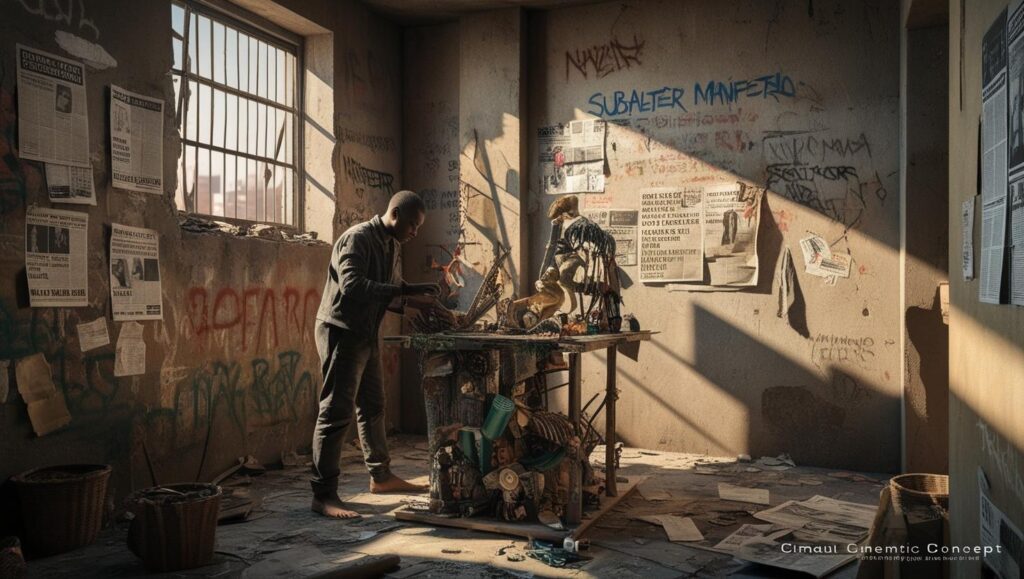Within the evolving discourse of contemporary aesthetic theory, the epistemological framework of Subaltern Poetics constitutes a vital theoretical intervention that problematizes conventional paradigms of power relations and representational practices in contemporary art, while simultaneously interrogating the ontological assumptions underlying traditional artistic hierarchies. This theoretical framework derives from the intersection between the Aristotelian notion of poetics and subaltern studies, initially developed in the Indian post-colonial context of the 1970s. Contemporary poetics transcends its etymological origin related to poetic creation, establishing itself as an expanded field for investigating artistic practices and their methodologies. This conceptual expansion enables the analysis of artistic manifestations as processes of subjective transformation that convert ordinary experiences into extraordinary moments of significance.
Subalternity, grounded in the seminal works of Ranajit Guha and Gayatri Spivak, presents itself as an analytical category examining power relations and subordination in contemporary societies. This concept encompasses multiple dimensions of marginalization, including class, caste, gender, and labor conditions. Within this theoretical framework, Subaltern Poetics emerges as a theoretical-methodological field investigating artistic manifestations produced from positions of social, cultural, and political marginality. This approach examines how contemporary artistic practices articulate resistance and propose alternative narratives to established hegemonies.
The systematic questioning of established power structures in contemporary art characterizes Subaltern Poetics, proposing new methodologies of analysis and artistic creation that privilege traditionally marginalized perspectives. Subaltern artistic manifestations frequently employ unconventional materialities and experimental processes as a strategy of resistance to institutional art. The incorporation of autobiographical narratives and collective memories constitutes a central element in constructing subaltern poetics, establishing connections between individual experiences and broader historical processes.
The analysis of Subaltern Poetics requires an interdisciplinary approach combining visual analysis methodologies, cultural and post-colonial studies, contemporary critical theory, visual anthropology, and sociology of art. In contemporary art, Subaltern Poetics manifests through various practices, including forensic and investigative art documenting systemic violence, installations questioning spatial and institutional hierarchies, performances problematizing power relations, collaborative artistic practices challenging individual authorship, and urban interventions resignifying marginalized spaces.
Subaltern Poetics should not be understood as a static or essentialist category but as a dynamic field of investigation continuously reconstituting itself in response to contemporary social and artistic transformations. This theoretical approach enables a more nuanced understanding of the relationships between art, power, and resistance. The conceptual framework establishes itself as a fundamental theoretical-methodological instrument for analyzing and understanding contemporary artistic practices emerging from positions of marginality. Its relevance lies in the capacity to articulate aesthetic and political questions, contributing to a critical reorganization of the contemporary artistic field.
The development of this theoretical field is grounded in significant contributions from subaltern studies, post-colonial theory, and institutional critique, establishing productive dialogues with thinkers such as Spivak, Guha, and contemporary art theorists. This interdisciplinary approach has fostered a deeper understanding of how marginalized voices find expression through artistic practices, challenging traditional power structures within the art world. The theoretical framework provides a critical lens to examine how artistic production from subaltern positions contributes to broader discourses of resistance and cultural transformation.
The implications of Subaltern Poetics extend beyond purely aesthetic considerations, encompassing broader questions of cultural politics, institutional power, and social justice. Through this theoretical framework, scholars and practitioners can better understand how artistic practices serve as vehicles for subaltern expression and resistance, while simultaneously acknowledging the complex power dynamics that continue to shape the contemporary art world. This understanding contributes to a more nuanced appreciation of how marginalized voices navigate and challenge established artistic hierarchies, ultimately enriching our comprehension of contemporary art’s role in social and political discourse.

